- So PC Magazine’s like “here’s the new AOL redesign.”
- And Kara Swisher, now with Cnet, is like “oh no you dint. here’s the real new AOL redesign.”
- Then WVFF is like, zup y’all… I’ve got the REAL AOL redesign as an ass-clue-sive. Hot, snap, sizzle.
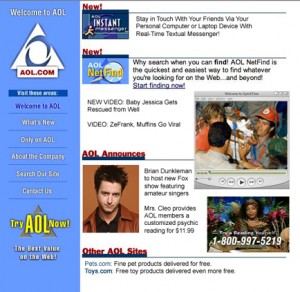

Call it a subtle scent at this week’s Ad:Tech in NYC… Lots of discussion of online-video, even if not in proportion to online-video’s growing importance to the online-marketing mix. More interesting, however, is that most conversations didn’t use the two words: “you” and “tube.” People talked about contextual targeting, video-advertising networks, and even facial recognition.
Even though every attendee received a free Fast Company that featured YouTube influencers, the words “You” and “Tube” weren’t muttered except in disgust. Even Google’s mainstream booth didn’t showcase YouTube. WTF?
Why? How was it that people would only discuss YouTube when I brought it up? And why was all the feedback negative:
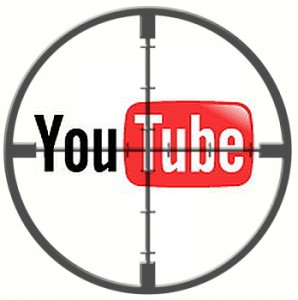 They’re not selling inventory well. They’re not even making it easy for us to buy it.
They’re not selling inventory well. They’re not even making it easy for us to buy it.The “Madison YouTube Snub” wasn’t about the proximity of ads to “consumer generated content,” or about metrics or targeting. It was simply that agency buyers (as haughty as I know they can be) aren’t being treated well.
What YouTube is missing is the “Great Irrationality of Marketing Spending,” something I’ve grown to understand even if I disdain. I’ve seen it closely from all three perspectives: as a content creator, a buyer, and an intermediary. While we direct-response oriented marketers (the ones who track A/B campaigns on Google OCD style) are about results, the vast majority of advertising spending is not rational or performance driven. There. I said it. Try to refute that fact.
I’m not suggesting that media buyers are behaving recklessly or spending without consideration of their client’s money. But I do know that when confronted with a new medium with unclear metrics, they buy based on a) what’s easy, b) what they understand, and c) relationships.
I know how devalued my 4-6 million monthly views on YouTube are, and how the cost-per-view is horrifically low. So this article is a bit biased. But I also know I can’t solve that myself… it’s going to take some improvements in San Bruno. I would typically provide this advise without public fanfare as “not to bite the hand that feeds me.” I wouldn’t have an audience without YouTube. But I owe it to myself and fellow creators to help YouTube solve its biggest problem: poor monetization of traffic.
So here are 7 tips for YouTube to win back the hearts and dollars of Madison Avenue.
 Be Nice. You don’t have to contort your business model to fit advertisers, but at least show them love.
Be Nice. You don’t have to contort your business model to fit advertisers, but at least show them love.Any other tips? Or are you just gonna hope it takes care of itself?
Fast Company’s November issue takes on the subject of online influencers, with prominent features of YouTubers, iJustine and MysteryGuitarMan. The piece provided some nice insights into the “going rate” of a weblebrity/webstar… mid-high six figure incomes with $20-$50K per sponsored videos. Sustainable?
Techcrunch took objection to the piece and brought it out back for a good-times ass whooping. And to that I shout, “fight, fight, fight” (and hope nobody kicks my ass while I get some good footage). Here’s a picture of Justine Ezarik. I’m not swiping the one of Joe Penna (MGM) because I’m too lazy.

The real surprise of the article, beyond such trivial disputes as to “what defines online influence,” is this… who would have thought that 4Chan’s “Moot” would be fairly zit free, thin, and (dare I concede without sounding perverted) handsome? Is this an elaborate plot by “Anonymous” to give Moot a fake image, torn from some J. Crew catalog or an Asian teen porn magazine?

Yeah I’d say we’ve been punked. That aint Moot. Here’s the real Moot. But you gotta love 4Chan. I’ll bet they cleverly manipulated all of the influence data, showing that Fast Company and TechCrunch are both wrong. Fight, fight, fight!

Just remember kids… I may not be in the cool crowd, but I knew them when.
Video ad serving is changing dramatically, as video ad units become better targeted, more “real time,” and less “black box” to those executing and measuring a campaign (read: more accountable). Today’s AdTech:NYC “Marketing Masters: Video Everywhere” session at 3:15 at the Javits Center (hosted by Nalts) is exploring these themes. It’s a continuation of the Marketing Masters series: “Video Everywhere—Brand Lift and Awareness with Online Video” and “Deep Brand Integration in Online Video.”
Presenters include leaders from 3 leading firms: Affine Systems, AOL Time Warner, and Dynamic Video.
➢ Affine Systems is using computer-vision technology to “shine a bright light on the current black box of broadband video.”
➢ AOL is familiar to us all, but it’s made news this week for a redesigned homepage that focuses more on video than ever. Editor picks are featured on the homepage.
➢ Dynamic Video, like its name implies, focuses on dynamic creative marketing and rich media advertising, delivered “on the fly” to keep it fresh, targeted, measured, and optimized.
The peeps:
More news to follow if we uncover something amazing and newsworthy. 🙂
Steve Garfield, the “Paul Revere of video blogging,” will join Pixability CEO Bettina Hein in a free 1-hour webinar on December 1, featuring latest trends in online video and related media. Topics include:
Garfield also is raffling off ten copies of “Get Seen: Online Video Secrets.” Space is limited, so register now for the free webinar, held December 1, 2010 from 12:30 p.m. to 1:30 p.m.
Garfield’s book is part of David M. Scott’s “New Rules of Social Media,” which also includes my book (Beyond Viral).
“Video advertising is still ‘in its diapers’… you gotta remember that most people don’t want to see ads” said eMarketer’s David Hallerman in a webcast last Thursday (October 21, 2010). eMarketer provided highlights from a report (“Video Advertisement Engagement: What Marketers Need to Know”) in the one-hour webinar, and slides are excerpted from that.
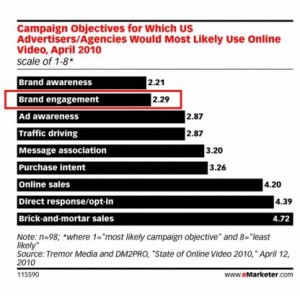
Hallerman says online-video is the most expensive form of digital advertising, and skews toward professional content not user-generated. He explores both the definitions and forms of engagement. Per the chart on the right, awareness is still the #1 goal of marketers followed closely by engagement (according to an April 2010 study by Tremor Media of 98 advertisers/agencies).
So what is engagement? Some say it’s paying attention, others refer to interactivity, and still others refer to what happens afterwards.
I’d prefer to focus on what Hallerman calls server based data (a view, start-rate, completion time, mouse-over, sharing) and not survey data (like “brand health” metrics like awareness or intent, reported by Insight Express or Dynamic Logic). However those “brand health” metrics can be vital to determining “intent to buy,” which is often not captured by server metrics (although some cookies provide advertisers data about purchases that occur long after a video view).
Engagement metrics include:
Context is also important… an auto-roll on gaming or entertainment site is not going to be as powerful as a self-directed and completed video on a shopping site. Hallerman reminds us that consumers value HD (above many other factors) and that quality (original versus repurposed) is vital, and that’s an important insight. During the Q&A Hallerman later acknowledged that some studies are showing that repurposed television commercials are faring better than once expected.
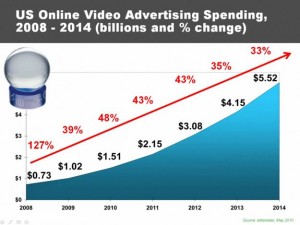
eMarketer projects continued growth of the medium as depicted above — reaching at least $5.5 billion by 2014. But when it comes to online-video ad views, all video sites aren’t created equally (comScore, Sept. 30, 2010). The report shows that “ads per viewer” on Hulu is more than seven times higher than Google/YouTube sites. See the rank of video-advertising properties, and Hulu tops followed by Brightcove and Tremor Media (both which serve ads on websites not exclusively devoted to video content). At 30 ads per viewer per month, it’s no wonder Hulu is considering cutting its monthly subscription in half.
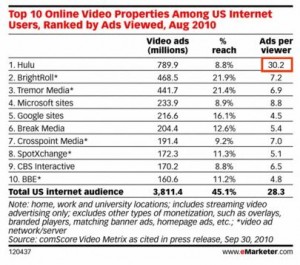
Time per month per viewer on YouTube is nearly twice that of Hulu, despite Hulu’s content being generally longer (22 minute shows versus 2-3 minute videos). Hallerman refers to Hulu’s experience as “lean back” because we allow the show “to wash over” us, whereas other sites (YouTube) require a more “lean forward” experience. Marketers, says Hallerman, are looking for what they know from broadcast advertising — pre or mid-rolls played “in stream” during a video’s view.
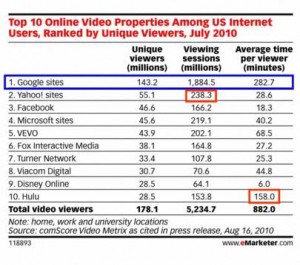
Marketers choose ad-networks to target online-video ads based on two factors: demographic or content. A beauty ad on Break.com, Hallerman explains, won’t likely get high engagement. As for viral?
“…You don’t just make something go viral,” Hallermans says. “It’s really a whole process that needs a blend of paid, owned and earned.” He provides the recent Old Spice example, which involved paid ads on television and the web, a microsite showing more content, and “earned” media where video answers responded to specific bloggers. He credits the paid ads were the “spark.”
Aside from viral or its own reason, here are what some marketers claim to have accomplished on YouTube. So one in five (20%) say their YouTube videos have driven sales via links. But recognize that the data are not saying that happens twenty percent of the time- it’s usually in the low single digits in my experience.
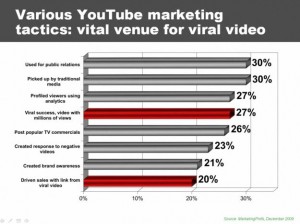
Branded content (where the marketing is not “heavy handed” and is “almost a bi-product”) is the most effective forms of marketing according to an October 2010 report by the CMO Council. Branded content tops more traditional online advertising models or even database-driven behavioral marketing. Video content, for instance, about dogs with dog-food product placement… may have a greater impact than dog-food ads alone. “Creating an experience,” Hallerman says, “is hard but important.” These can be tracked by brand-equity scores. He provides another example of a hair-care product that might show entertaining or educational fashion tips (focusing on benefits) rather than advertising about the product (features).
During the eMarketer webcast, EyeWonder shared “server side” data that show higher engagement rates for ads in the financial sector, with travel or electronics on the low side of engagements. EyeWonder showed a case study involving Gatorade’s G Series, which featured a 15-second ad that allows customers to see how the beverage helps before, during and after an athletic event. The click-thru rate was a tame .13%, but the a video completion rate was an impressive 62% across all of the impressions.
Hallerman was asked to comment on how to make a video more likely to be viral, but said if he had the answer he’d be working at an agency. Perhaps he just needs a copy of “Beyond Viral.” 🙂
There’s been a lively debate recently among online-video enthusiasts about Google/YouTube’s capacity to sell display advertising. Sales people need different skill sets selling paid-search (automated, measurable, bid-based) versus display advertising (which is less measurable and more like selling television or print). To understand the distinction, see Google’s video; this is something we’ve been exploring at WillVideoForFood since Google bought YouTube in 2007. While Google has deep relationships with top companies and industries, it has only recently put emphasis behind non-search advertising.
YouTube’s display team (a few dozen) is rather small, and most YouTube ads are sold via Google Adwords not the dedicated team. While the display team sometimes lands some comprehensive ad buys with advertising agencies and brands, most monetization on YouTube is marginalized. The CPMs (cost per thousand) are so disappointing to some creators and online-video studios that some (from Next New Network and Revision3 to TheStation) have begun to sell their own inventory, or partner with ad networks that can attract better monetization for their views. Increasingly YouTube has provided creators and intermediaries tools to sell their inventory directly.
That said, there was some encouraging news from Jonathon Rosenberg, Google’s SVP for product management. According to this eWeek piece titled “Google YouTube, Android Drive $3.5B in Ads.”
Google’s display ad business… operating at an annualized run-rate of $2.5 billion. That’s counting YouTube ads, and all non-text ads running on Google’s network and DoubleClick networks, Jonathan Rosenberg, Google’s senior vice president of product management, said on the Q3 earnings call. “You guys always ask me (referring to analysts)… where’s your next multi-billion dollar business after search,” Rosenberg said. “There’s your answer.”
As I mentioned in a recent video (“Advertising Doesn’t Have to Suck,” I’m off to Blogworld. It’s the “South by Southwest” of social media, and packed with bloggers, vloggers, and even stupid people. Steve Garfield (fellow video enthusiast) is leading a session, and we’re both doing book signings on Friday. On Friday, he signs “Get Seen” at 2:00 and I sign “Beyond Viral” at 2:30. I plan to stalk his fans holding a sign that says, “if you liked Get Seen, you might also like Beyond Viral.”
Sadly Samsung’s Galaxy never came through, so I won’t be smashing my iPad. I tried. However I will be stalking Kent Nichols and Jim Louderback (cheesy photo below). You can bet on that.
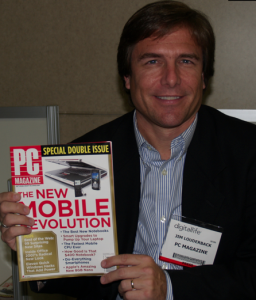
Friends, don’t be anti-social media… come hang. (See “anti-social media” below):
Fresh new data about online-video views, sharing and viewers! The source is YouTube, Next New Networks and Frank N. Magid & Associates (see press release and blog), and the data was collected between May 18 and June 4, 2010. While it’s not super fresh, it’s filling a void in the past year.
Two important take-aways: First, the audience is digging its online video. More than half of those surveyed (people who have watched Web original videos) deem them to be just as, if not more, entertaining than what they view on traditional television. Did you hear that? As good as TV. And 25% find it more entertaining than traditional television. That explains why these folks are 2.5 times more likely to be “engaged.” They’re clearly watching more sophisticated content than mine.
Now before we get too excited, clearly YouTube and Next New Networks aren’t exactly objective here. Both have something to gain from convincing advertisers that this web-video fad, like the Fushigi and pet rock, is here to stay. However there are two things that make me inclined to trust the data: First, hopefully someone with a website as boring as Frank Magid’s is keeping an eye on the methodology and sample. Secondly, YouTube/Google almost NEVER shares data. So that’s a big deal.
I’m never sure what to do with excerpts like “four out of ten share videos,” because I’m more interested in how often they share. For instance, I’d be among the percentage of people who has seen my dentist in the past year (hey look I made him a website: drjeffreymercando.com). But that overlooks the reality that I’d not seen him for several years prior to my visit last month. If you surveyed me if I floss, I’d say yes. But how often?
The second interesting fact about this collective study is that online-video viewers are indeed young: mostly 18-34. There was no shame in the way YouTube/NNN and Magid depicted the demographic of online-video viewers. Rather than trying to dance around one of the leading concerns advertisers have about any new medium (that their target isn’t there)… YouTube & Next New Networks tell it like it is:
“According to recent Nielsen reports, the average age of television viewers is over the age of 50. However, this research revealed that 18-34 year old Web original viewers constituted 65% of the National sample, 73% of the YouTube sample, and 90% of Next New Networks’ sample. Not only does the coveted 18-34 demographic spend many hours viewing video online on a regular basis, but the research shows that this time spent with online video and Web original content leads to less time with TV. Web original video viewers spend 13% less time with TV than non-viewers.”

So these fellas are kinda saying, “yeah we’re not television… but our audience is more engaged, and it’s that coveted 18-34 year olds who spend a lot of money.” And then it tosses in the fact that for these peeps, television isn’t growing. This demo, according to the research, is 13% less likely to watch the boob tube.
I present this cautiously. I recall the advertiser trepidation with the Internet itself, based on the assumption that online surfers were all college kids, and we (almost overnight) saw that change. Now, of course, online-use kinda mirrors the general population (at least in the U.S.)… that’s where this is heading. Eventually, like it’s true for the web, any target can be found via online video, with varying degrees of precision and scale. So I don’t want to let brands targeting different audiences, “off the hook.” Media buyers hold demographic data like Irish people hold grudges, and we don’t want to see advertisers write online-video off as the medium for just for Vodka, Kaplan, and Sandals Resorts. I think we need to keep a close eye on how online-video viewership of moms and boomers grow in the next months and years.
That being said, it skews young right now. Let’s face it and embrace it. Anyone up for cramming for the GMATS over a martini in Jamaica?
“The findings are an incredible point of validation for Web original programming as a key source of entertainment and viewers find it to be on par with television programming,” said Rick Silvestrini, Product Marketing Manager at YouTube, while holding in a 27-year-old fart.
Speaking of Silvestrini, below is my video remix of him, inspired by a comment I noticed about his original video where someone swears they heard a fart. Is this tasteless? Yes. Biting the hand that feeds you? Perhpaps. But could you expect me to restrain myself? No way.
No offense Rick. I’m the same guy that stuck Jordan Hoffner’s sound bite about advertisers fearing cats on skateboards into a “best of cats on skateboards” remix. And Chad Hurley still thinks of the anchovy pizza video when he sees me. It’s love… it’s just tough love.
Curious about the different ad formats available on YouTube? Here’s a video by Product Marketing Manager Rick Silvestrini, in which he answers common questions (frequently asked questions or “FAQ”) about how ads work — it’s posted today on YouTube’s YouTube channel.